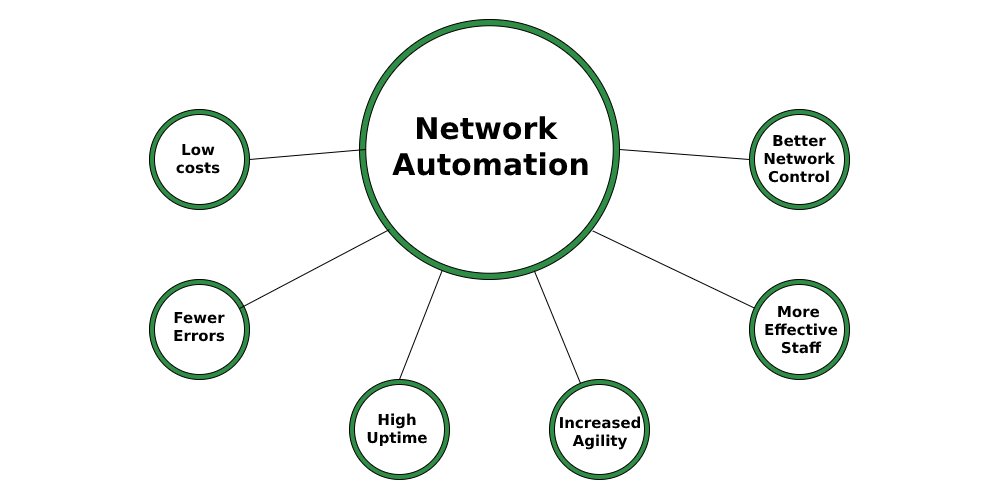What is Network Automation?
Network automation involves using software to automate the provisioning and management of networks and security. Its aim is to consistently maximize network efficiency and functionality, often alongside network virtualization. Today, IT departments prioritize speed, agility, and consistency in managing traditional and cloud-native applications. Modern network automation platforms achieve these goals by automating tasks such as resource provisioning, network mapping, and network testing.

ad
Why Network Automation?
Network Automation facilitates rapid application deployment by automating network and security provisioning and management throughout the entire application lifecycle, across both data center and cloud environments.
Elevate Your IT: Take the next step in digital transformation by virtualizing and automating network and security operations, traditionally hardware-centric and reliant on manual provisioning and management.
Accelerate App Development: Embrace new cloud-native applications and DevOps workflows with seamlessly integrated networking and security management that aligns with developer processes without necessitating extensive retooling.
ad
Enhance Visibility Across Environments: Replace limited perspectives on network traffic and security dependencies with comprehensive visibility, enabling effortless troubleshooting of network and security policies across all environments.
How does network automation work?
Network automation software optimizes the mapping, configuration, provisioning, and management of networks efficiently. API-based automation eliminates the need for manual, command-line configurations on each networking device. These APIs can be directly invoked or accessed through programming languages like Python, Java, or Go. Beyond scripting, a contemporary automation platform monitors network resources during provisioning and ensures that configurations are validated before implementation, ensuring network readiness for any changes.
Intelligent network automation
Advanced intelligent network automation leverages machine learning and big data to optimize network configuration and management according to specific business objectives. This approach involves a centralized, high-level perspective of the entire network, rather than configuring each port or device individually, to ensure the network operates optimally to achieve these goals.
Intent-based networking provides a holistic view of how business requirements impact the network and proposes various solutions to fulfill these needs. This approach is highly valued because it allows network engineers to scale the network efficiently for different purposes and minimizes misconfigurations caused by human errors.
Examples of network automation
When integrating network automation with virtualization, software-defined networking (SDN) merges with network functions virtualization (NFV) technology to configure and adapt the network based on business or service goals. SDN controls how hardware devices operate, enabling administrators to establish virtual software networks between virtual machines or manage multiple physical networks using networking software.
This combination of network virtualization and automation proves invaluable in environments susceptible to sudden spikes in usage. Automated networks can efficiently manage these surges by automatically redirecting network traffic to less congested server areas within the network.
Various open-source initiatives are dedicated to establishing standards for network automation through virtualization. For instance, the European Telecommunications Standards Institute (ETSI) Industry Specification Group (ISG) for NFV Management and Orchestration (MANO) focuses on effectively managing and orchestrating network resources in cloud-based data centers. These standards aim to foster improved communication between SDN and NFV platforms.
FAQ’s
Why is Network Automation important?
Network Automation is crucial because it streamlines the provisioning and management of networks and security, enhancing efficiency and functionality. It supports rapid application deployment across diverse environments, including data centers and the cloud.
How does network automation improve IT operations?
By automating tasks like resource provisioning, network mapping, and testing, network automation frees up IT resources, accelerates application development cycles, and ensures consistent management of both traditional and cloud-native applications.
What are the key benefits of network automation?
Network automation boosts agility by reducing manual configuration efforts, enhances visibility across network environments for improved troubleshooting, and supports scalability without the risk of configuration errors.
What technologies are involved in network automation?
Network automation utilizes API-based automation, integrating with programming languages such as Python, Java, or Go to configure and manage network resources efficiently. It also incorporates intelligent automation leveraging machine learning and big data for optimized network operations.
How does intent-based networking differ from traditional network management?
Intent-based networking takes a holistic approach, aligning network configurations with business goals. It offers automated responses to network events and conditions, enhancing scalability and minimizing human errors in network management.
Can you give examples of network automation in action?
Network automation is exemplified through technologies like SDN and NFV, which dynamically configure and manage network resources based on real-time demands and business objectives. These technologies enable efficient management of virtual networks and physical infrastructure, crucial for handling unexpected usage spikes.
What role do open-source initiatives play in advancing network automation?
Open-source projects, such as those led by ETSI’s Industry Specification Group for NFV Management and Orchestration (MANO), establish standards for effectively managing and orchestrating network resources in cloud-based environments. These initiatives foster interoperability and innovation in network automation technologies.
Conclusion
Network automation represents a transformative shift in IT infrastructure, enabling organizations to deploy, manage, and scale networks with unprecedented efficiency and reliability. Through technologies like API-based scripting, machine learning-driven automation, and intent-based networking, businesses enhance agility, accelerate application deployment, and mitigate operational risks. Embracing network automation isn’t just advantageous—it’s essential for organizations aiming to thrive in today’s fast-paced digital landscape.
ad


Comments are closed.